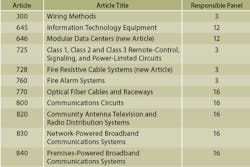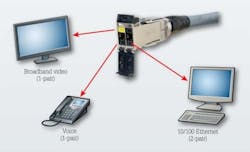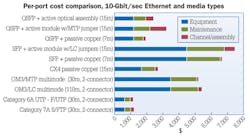The case for shielded cabling in healthcare facilities
The opportunity for cable sharing is among the many reasons shielded is a desirable option in hospitals and other healthcare environments.
By Robert Carlson, Siemon
In August 2010 the Telecommunications Industry Association (TIA; www.tiaonline.org) released TIA-1179 Healthcare Facility Telecommunications Infrastructure Standard, which specifies requirements for telecommunications infrastructure for healthcare facilities including cabling media, cabling topologies, cabling distances, pathways and spaces. Intended to support a wide range of clinical and non-clinical systems that can use an Internet Protocol (IP)-based infrastructure, the new standard comes on the heels of significant developments in the area of digital medical technologies, electronic healthcare records and growing IP convergence–all of which are better supported using shielded cabling technology over unshielded.
Snapshot of new standard
Due to the multitude of applications in today's healthcare environment, the new TIA-1179 standard offers a broader scope than the industry-recognized ANSI/TIA-568-C.0 Generic Telecommunications Cabling for Customer Premises. It makes recommendations regarding advanced network performance, larger telecommunications spaces, higher work-area density, redundancy and special application considerations.
Advanced network performance. For new healthcare installation, TIA-1179 recommends a minimum of Category 6A copper cabling and 850-nm laser-optimized 50/125-µm optical-fiber cabling, both of which are capable of supporting 10 Gigabit Ethernet. Given the bandwidth requirements and mission-critical nature of healthcare systems, the standard also recommends that whenever possible, designers give serious consideration to using the highest-performing media to allow for the longest possible lifecycle.
Larger telecommunications spaces. Due to the numerous services present in the healthcare environment, TIA-1179 recommends that telecommunications rooms (TRs) in a healthcare facility be larger than that suitable for a typical office-oriented commercial facility. Additional security measures are also recommended for TRs providing support for life and safety networks.
High work-area density. According to TIA-1179, the work area in a healthcare setting must take on a broader scope to support a multitude of applications. The standard defines various levels of density for work areas based on the type of spaces found in healthcare facilities. For example, low density is recommended for waiting rooms, medium density is recommended for exam rooms and high density is recommended for operating and intensive-care rooms.
Grove Hill Medical Center is one healthcare facility that took advantage of shielded cabling's ability to offer cable sharing–the use of a single cable for multiple applications. Grove Hill's IT director Carl Labbadia says cable sharing "is solving an ongoing challenge."
Redundancy. Because critical areas in a healthcare setting can be severely impacted by loss of network access, TIA-1179 recommends a minimum of two diverse backbone pathways and cables to provide redundancy for these areas.
Special application considerations. TIA-1179 provides installation and testing recommendations regarding infection-control requirements, areas with high levels of electromagnetic and radio-frequency interference (EMI/RFI) and other areas of a healthcare facility that may expose cabling to the detrimental effects of high magnetic fields, radiation, high temperature and chemicals.
A need for 10 Gig
Advanced network performance is recommended for healthcare facilities primarily due to the vast amount of electronic health information and higher file sizes associated with digital images like x-rays, MRI images and CT scans. Looking at the types of files that move across a healthcare network, one can see concrete justification for deploying 10 Gigabit Ethernet in a healthcare facility. A fused positron emission tomography and computed tomography (PET/CT) scan used to measure both metabolic and structure cannot be compressed and is approximately a 30-Gigabyte raw image. Assuming best-case data throughput, a file of this size take just 24 seconds to transmit over a 10 Gigabit Ethernet network but can take as long as 40 minutes to transmit over a 100 Megabit Ethernet network. Medical professionals cannot afford the time associated with waiting for large image files to move across the network, especially when lives are on the line.
Furthermore, as more healthcare facilities move away from paper records, advanced network performance is required to transmit and store the increasing amount of electronic health information. As part of the 2009 American Recovery and Reinvestment Act (ARRA), the United States government passed the Health Information Technology for Economic and Clinical Health (HITECH) Act, which provides funding to hospitals and physicians for the adoption of health information technology. Another key driver in the shift toward electronic healthcare information is the Health Insurance Portability and Accountability Act (HIPAA) of 1996, which standardizes electronic data interchange, facilitating greater exchange and portability of healthcare information.
Healthcare facilities are also built to last for decades, and their 24/7 operation and infection-control requirements have a serious impact on the ability to perform cabling moves, adds and changes. Infection-control measures in a hospital environment include serious regulations for accessing the plenum (air-handling) space. To recable or add cables in this environment, the entire area is typically required to be shut down due to the possibility of airborne contaminants. This is extremely disruptive and can impact patient care. Installing the highest-performing cabling up front allows for the longest possible lifecycle and least potential need for replacement.
Per TIA standards, Category 6A cable is de-rated with respect to link-length support depending on the temperature in the cabling environment. As this graph shows, however, UTP cable is subject to more-significant de-rating than F/UTP is.
Convergence and PoE
Today's healthcare facilities include a multitude of applications ranging from patient monitoring and medical imaging to electronic record keeping and inventory management. Wireless is also becoming more prevalent in healthcare facilities to support a variety of mobile applications like nurse call and physician order entry systems. At the same time, IP convergence is starting to take hold as more life-safety, security and building automation systems and devices are able to communicate over IP networks. Many healthcare facilities are even taking advantage of IP convergence to monitor temperature in pharmaceutical refrigerators, deploy synchronized clock systems and broadcast video over IP to patient rooms, creating the need for higher-density work areas and the potential for congested cabling pathways.
As the number and variety of devices using IP increase, Power over Ethernet (PoE) is becoming commonplace to deliver power over network cabling to many of these devices, including wireless access points, telephones, thermostats, radio frequency identification (RFID) readers, security cameras and access-card readers.
Ratified in September 2009, the IEEE 802.3at-2009 PoE standard, known as PoE Plus, provides up to 25.5 W of power. PoE Plus has paved the way for many power-hungry devices to now be powered over network cabling, including pan-tilt-zoom cameras, biometric sensors, door locks and laptop computers. The higher power delivered by PoE Plus causes a temperature rise within the cabling, which can result in increased insertion loss that negatively impacts network performance.
Interface issues
Some areas of the healthcare facility can potentially involve high levels of EMI/RFI from diagnostics and radiology equipment. EMI can interrupt or degrade the transmission of electronic healthcare information over the network. TIA-1179 states that cables supporting data transmission in these areas may require appropriate isolation to reduce the effects of EMI. The new standard actually recommends testing cabling performance during operation of equipment, especially in the case of MRI equipment that is known for causing high levels of interference.
Fully shielded cabling systems are making their way into healthcare environments, the author says, thanks to their performance, ability to facilitate work-area density, heat-dissipation characteristics, and immunity to outside interference.
Other areas of a healthcare facility may expose cabling to the detrimental effects of high magnetic fields, radiation, high temperatures and chemicals, requiring cabling solutions that are able to ensure network performance in these areas. As the number of wireless access points increases in conjunction with wireless network speeds, there is the potential for increased levels of RFI. Distributed antenna systems for cellular phone service, RFID systems and other systems can also cause RFI in a healthcare facility. According to TIA-1179, both the cabling and its location should be selected to minimize these effects.
The optimum solution
Many of the cabling challenges surrounding applications in a healthcare facility can be easily avoided by using shielded cabling technology. In fact, early draft versions of TIA-1179 went as far as to recommend shielded cabling for healthcare facilities, but the recommendation was edited out of the final standard.
Network performance. When it comes to providing the advanced network performance recommended for healthcare facilities, shielded systems provide much more headroom than unshielded systems due to superior crosstalk and external noise immunity and support for higher signal-to-noise ratio margins. Unlike unshielded cabling, the physical robustness of the shield virtually eliminates the potential for alien crosstalk to be introduced into the system and degrade network performance. Using shielded cabling eliminates the need for time-consuming field testing for alien crosstalk, which speeds deployment and saves time and money. And as network speeds continue to increase, only fiber or fully shielded systems like Class F (Category 7) and Class FA (Category 7A) will be able to support network speeds beyond 10 Gbits/sec. These systems enjoy the longest lifecycle of any copper cabling available, which is ideal for the healthcare environment.
Work area density. To support a multitude of applications in a healthcare setting, TIA-1179 recommends higher work-area density. Higher density at the work area requires a greater number of cables and ensuring pathway congestion. One advantage to using a fully shielded cable like Category 7A is the ability to deploy cable sharing–the use of a single cable for multiple applications. Because a Category 7A shielded cable includes four fully shielded pairs, the cable can actually be split to support up to four applications at one work area location. Using a variety of 1-, 2- and 4-pair patch-cord options, the fully shielded design supports a variety of application combinations, such as two 10/100-Mbit Ethernet connections, two Voice over Internet Protocol (VoIP) phone connections, or four cable TV video feeds. This cost-effectively supports higher work-area density, eliminating the need to deploy one cable for every connection and significantly reducing pathway congestion. Cable sharing is not possible with unshielded cable.
Dissipating heat for PoE. With PoE and PoE Plus causing temperatures to rise within the cabling potentially resulting in increased insertion loss, it makes sense to choose cabling systems that are better able to dissipate that heat. To address the issue of rising temperature in the cabling environment, standards specify a temperature-depending de-rating factor to determine the maximum horizontal cable distance at temperatures above ambient 20 deg. Celsius. However, the de-rating adjustment made for unshielded cabling allows for a much greater insertion loss. On the other hand, shielded cabling systems have a more stable transmission at elevated temperatures, reducing the need for shorter channels. With shielded cabling better able to support PoE Plus for cameras, magnetic-lock doors and other security and building-automation devices, it is also therefore easier to support IP convergence in a healthcare facility.
EMI/RFI immunity. Optical-fiber cabling provides EMI/RFI immunity, but it is not typically deployed in the horizontal cabling pathways due to its higher equipment costs and inability to support PoE applications. When it comes to cost-effective copper cabling systems, only shielded cabling offers EMI/RFI immunity. In fact, screened and fully shielded cables offer 100 to 1,000 times the immunity protection from electric fields than unshielded cables do. This is critical in areas of a healthcare facility that experience high EMI/RFI. And as healthcare facilities deploy more medical equipment with unknown levels of EMI and increase the use of RFI-causing wireless applications, the use of shielded cabling becomes even more essential in this environment.
Hospitals and healthcare facilities are choosing to deploy shielded cabling over unshielded due to its ability to provide superior network performance, higher work-area density, better heat dissipation and EMI/RFI immunity. Following are two examples of shielded cabling being deployed to better support today's and tomorrow's advanced medical technologies.
Grove Hill Medical Center
Home to more than 70 physicians, Grove Hill Medical Center (www.grovehill.com), is a multi-specialty clinic that covers 19 medical specialties, including cardiology, oncology, orthopedics and radiology. Like any facility dealing with critical and secure transmissions, network performance was a primary concern for Grove Hill when it came time to upgrade their network cabling infrastructure.
"We now process 150 to 200 radiology images per day, and those files are getting exponentially bigger with better imaging technology," says Carl Labbadia, IT director at Grove Hill. "Today's 16-slice CAT scan can generate a 2,000-image, 2-Gigabyte file, and tomorrow's will only grow. Network speed and bandwidth is critical to real-time transfer in the medical field, and the cabling needs to be ready to support it."
Offering bandwidth of 1,000 MHz, a Category 7A fully shielded solution was chosen to meet Grove Hill's diagnostic imaging requirements and offer additional headroom for future advancements. In addition to bandwidth, the fully shielded cable was the only choice that enabled cable sharing and the ability to support up to four applications over a single cable.
"Cable sharing is solving an ongoing challenge for Grove Hill," explains Labbadia. "If we need a phone in a patient room, a TV, or an Ethernet connection for a physician to review treatment information with patients, we already have the connectivity in place."
Riverbend Medical Group
A multi-specialty medical facility with six locations, Riverbend Medical Group's IT department manages the practices of approximately 100 medical providers as part of Physicians Practice Partners (www.physpartners.com), a physician directed practice management company that develops and integrates electronic healthcare records, physician practice management systems and medical billing and insurance coding systems.
Although older network infrastructure cabling is a mix of Category 3, 5, 5e and 6 UTP, Category 7A shielded cabling has become the standard for all new copper cabling at Riverbend facilities, where it is being deployed throughout the data center and in the horizontal infrastructure to support a variety of applications like PoE, cable TV, IP cameras, building-control systems, Voice over Internet Protocol, TCP/IP and analog systems.
"Our medical facilities tend to change frequently, which means devices that produce electrical interference can end up being installed near existing cabling," says Frank Bowrys, systems administrator for Riverbend. "The Category 7A shielded solution we chose from Siemon provides superior performance when we need to renovate and run a cable channel in a location where UTP would be susceptible to interference. As a medical facility, we are also responsible for the security of HIPAA privacy-protected data. Our Category 7A solution meets strict TEMPEST [Telecommunications Electronics Material Protected from Emanating Spurious Transmissions] test requirements used for high-security military installations."
Category 7A shielded cabling saves Riverbend money over the lifetime of the cabling system by allowing them to only have to cable once and ultimately ensure a protected investment. "We also save money in the short term as well," says Bowrys. "With Category 7A, we need fewer cable runs and connectors and patch panel space than with a Category 6A installation. On one outlet, we can put four analog devices, or two workstations and two phones that function at 100-Mbits/sec each. We also can run cable TV over the same cable–something we cannot do with Category 6A UTP."
According to Bowrys, deploying Category 7A shielded cabling offers an added benefit when troubleshooting medical equipment. "We work with many vendors for a variety of services. When a problem comes along, vendors often try to throw the problem back at us. In the past we have had to change patch cables, switch ports, outlets and even switches in an attempt to rule them out before a vendor was willing to troubleshoot the problem," he says. "Now if there is an issue with something like mammography application performance, we simply tell the vendor that we are using a Category 7A shielded network on the private VLAN [virtual local area network], with 12 mammography devices with a proven history of performance with no errors or failures and bandwidth usage that is one-tenth of what is available. That kind of information gets vendors to stop pointing fingers and find the problem on their end."
Robert Carlson is vice president for Siemon www.siemon.com.
Past CIM Issues




